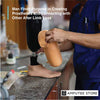Advancing Neural Prosthetic Limbs
Although there are already existing advanced and refined lower- and upper-limb prostheses, most prosthetic users still report that they can't manage their artificial limbs intuitively or understand sensations coming from their prosthetic limbs. These issues lead to decreased mobility, heart fatigue, and susceptibility to falling. Ultimately, these deficiencies lead the prosthetic user to feel like the artificial limb is not a part of their body, which is the main reason for prosthetic abandonment.

A better human-computer interface that allows two-way communication between the prosthetic user and the artificial limb seems to be the answer to solving this problem. This is why researchers are looking to neural prostheses (NP) for its bidirectional or two-way interface. Neural prosthetic devices are assistive devices that restore functions lost to neural damage. These implanted or external devices can electrically stimulate nerves.
Several neurotechnologies are known to allow the prosthetic user to operate their prosthetic limbs and restore sensation. However, researchers still need to overcome numerous challenges.
Prosthetic limb actuation
Targeted muscular reinnervation (TMR) can reroute nerves, making it a possible solution for enabling NPs. Previous TMR procedures gave shoulder-level amputees the ability to contract their chest muscle tissue, while above-knee amputees could tighten their muscles.
However, since prosthetic management relies on the electrodes laying on the skin, researchers noticed an instability due to electrode motion or detachment.
This led to the development of the regenerative nerve interface strategy, which was first tested on upper-limb amputees. The bisected peripheral nerve within the residual limb was sewn into a muscle graft implanted with recording wires. The wires then connect the residual limb to prosthetic controls through the cables that pass through the skin. However, this method can lead to infections. If not for the possibility of developing infections, this biointerface would have been great at enabling high-precision prosthetic management, including single-finger actions, which was seen in two amputee participants.
Researchers developed tiny implantable myoelectric sensors (IMES)—injected into the reinnervated muscle tissue—to avoid possible skin issues. This was tested on three above-elbow amputee volunteers. Researchers noted that this method proved useful for long-term use.
Sensory restoration
Alongside the ability to operate prosthetic limbs, restoring sensory information from the artificial limb to the user is essential. Phantom sensations can be induced by electrically stimulating nerves directly beside the amputation site.
Researchers studied peripheral nerves, including fascicles, which transmit different sensations (usually similar to vibration and contact) from specific areas in the limb to restore sensation.
Several neural interfaces were developed for upper-limb amputees, including implanted transverse intrafascicular multichannel electrodes (TIME). These interfaces have been tested, and four upper-limb amputees reported experiencing tactile suggestions from their prosthetic limbs.
Stimulating leg nerves
Leg nerves are a bit more challenging to stimulate due to the larger nerves and different skin and pore density in the foot and sole than the palm. Most neurotechnologies mentioned above have been tested on upper-limb amputees so far.
Researchers implanted several TIMEs within the sciatic nerve—the longest nerve in the body—and evoked particular sensations in the artificial leg and foot of three above-knee amputees. This increased their confidence while walking with their prosthetic legs. It also improved their mobility on stairs, helped them avoid falls, and improved the artificial leg's embodiment while decreasing the unnecessary mental load throughout prosthetic use.
In the research mentioned above, different sensations have been restored in amputees. However, there may be limited proof for an improved sense of proprioception—a perception of where the limbs are in space and speed and energy. Proprioception is vital for walking.
As a response to this set of challenges in below-knee amputees, researchers developed a surgical approach that would activate agonist-antagonist muscle pairs. When these muscle pairs are activated, the mind perceives it as joint proprioception, which dramatically improves lower-limb amputees' performance when climbing stairs.
These different approaches have, so far, produced almost pure sensations. However, some participants report feeling an unpleasant electrical tingling.
The future of bidirectional neural prosthetic limbs
Bidirectional communication between the residual limb and prosthesis is instrumental in improving many prosthetic users' quality of life.
Future studies are expected to develop prosthetic digital skin and pores, which can accommodate sensors over versatile polymeric constructions. In the future, socks and gloves with high-resolution sensors transmit different sensory indicators close to temperature, stress, and motions may be available.
Furthermore, future bidirectional neural prosthetic limbs will be customizable to accommodate an individual's unique traits. In the long run, this will significantly improve a prosthetic user's quality of life.









































































